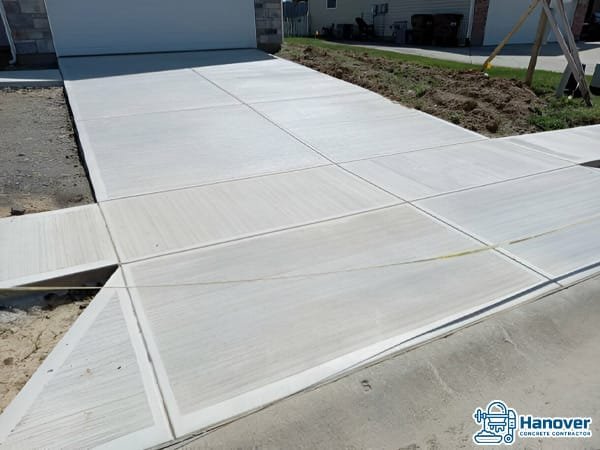I remember stepping out one morning and seeing the first crack in my driveway. It wasn’t a major issue yet, but it felt like a glimpse into the future—discoloration, more cracks, maybe even a costly repair down the road. For anyone who’s noticed those early signs of wear, it’s easy to feel a little overwhelmed.
You want to keep your driveway looking great and standing firm, but where do you start?
That’s precisely the position I found myself in. The good news? There are straightforward, effective ways to extend your driveway’s lifespan and keep it looking new. Let me show you how I tackled these challenges and got ahead of them before they became major problems.
Importance of Regular Driveway Maintenance
Your driveway isn’t just a functional piece of concrete or asphalt; it’s an investment. By keeping it well-maintained, you’re preserving its appearance, extending its lifespan, and saving money on costly repairs. Let me explain why regular care is so critical and what can happen if you let routine maintenance slide.
Why Regular Care is Essential
I’ve learned from experience that small, consistent efforts pay off big over time. Simple steps, like cleaning your driveway regularly and sealing it when needed, help prevent water from seeping into cracks and causing damage. Regular maintenance also makes your driveway safer. When you keep the surface clean and intact, there’s less chance of slips, falls, or vehicle damage. Overall, regular care isn’t just about aesthetics—it’s about protecting the long-term durability of your driveway.
Common Issues Caused by Neglect
Neglecting your driveway leads to problems that could have been avoided with minimal effort. For instance, cracks can grow larger as water freezes and expands in colder months, causing more extensive damage. Stains from oil or grease can penetrate the surface, making them difficult to remove and leaving an uneven, unattractive finish. Weeds can take root in small cracks, further widening them and breaking down the material.
Over time, a lack of maintenance results in costly repairs or even the need to replace the entire driveway. By staying on top of upkeep, you can avoid these common issues and keep your driveway in great shape for years.
Steps to Clean Your Driveway Effectively
Regular cleaning goes a long way toward keeping your driveway in good shape. Not only does it help maintain the surface’s appearance, but it also prevents dirt, debris, and spills from causing long-term damage. Let me share the steps I’ve found most effective for keeping a driveway clean and looking its best.

Removing Dirt and Debris
The first thing I do is give the entire driveway a thorough sweep. A stiff-bristle broom works well to clear away leaves, twigs, and loose dirt that can settle into small cracks or corners. A simple rinse with a garden hose loosens areas where dirt seems stuck before sweeping again. Removing this buildup regularly prevents debris from eroding the surface or creating slippery patches.
If you have access to a pressure washer, that can make the job even easier. I’ve found that even a lower-pressure setting is enough to remove ground-in dirt and restore the driveway’s clean, fresh look. Just be careful not to use too much pressure, as it can damage the surface if you’re not cautious.
Dealing with Stains and Spills
Oil stains and other spills can be stubborn, but addressing them early makes a big difference. When I notice a spill, I immediately blot up as much as possible with an old rag or paper towel. Then, I use a gentle cleaning solution—like a mixture of dish soap and warm water—to scrub the area with a nylon brush. Baking soda or a specialized driveway cleaner has worked wonders for tougher stains. I apply it directly to the stain, let it sit for a few minutes, and then scrub it away. A final rinse with water usually leaves the driveway looking as good as new.
Following these steps, you’ll find that cleaning your driveway is manageable and will keep it in excellent condition. Regularly clearing dirt and quickly tackling spills will make your driveway look better and last longer.
Protecting Your Driveway from Weather Damage
Keeping your driveway in good condition means staying ahead of the weather. Different seasons can take a toll on the surface, from intense summer heat to freezing winters. Using a sealer and planning for seasonal changes will protect your investment and extend its life.

Sealing to Prevent Cracks and Erosion
Sealing your driveway is one of the most effective ways to prevent cracks from forming. I’ve found that a quality sealant acts as a protective barrier, stopping water and chemicals from seeping into the material.
Once moisture gets in, it can freeze and expand, causing cracks to widen and leading to long-term erosion. Sealing also helps prevent damage from oil stains and road salt, which can slowly break down the surface over time. You’ll maintain a strong, stable driveway that meets the elements by sealing it every few years.
Preparing for Seasonal Changes
Weather can be unpredictable, but you can still plan ahead. Before winter sets in, I ensure the driveway is clean, and any small cracks are repaired. That way, water can’t get into the surface and freeze, causing larger cracks.
In the spring, I clean the driveway well and check for any new damage that may have happened over the colder months. For the summer, keeping it clear of debris and resealing if needed helps prevent sun-related fading and wear.
You’ll keep your driveway in better shape year-round by taking simple steps to prepare for each season. Sealing and staying ahead of weather-related damage are easy ways to ensure your driveway stays strong and looks great no matter what nature throws at it.
Repairing Cracks and Addressing Minor Damage
It’s normal for driveways to develop small cracks and minor surface issues over time. The key is addressing them quickly to avoid more significant problems. I’ve learned that with a little effort, you can prevent minor issues from becoming costly repairs.
Filling Small Cracks to Prevent the Spread
When you notice a small crack forming, taking care of it immediately is best. Using a concrete patch or crack filler works well for these minor gaps. Start by cleaning the crack thoroughly—use a stiff brush to remove any dirt or debris so the patch material adheres appropriately. Once it’s clean, apply the filler according to the manufacturer’s instructions.
A liquid crack sealer can often be poured in for hairline cracks, smoothing out the surface as it dries. These quick fixes prevent water from seeping in, freezing, and causing the crack to expand.
Handling Surface Spalling and Chips
When small pieces of concrete flake off, surface spalling might look like cosmetic damage, but it can lead to more significant issues. I’ve dealt with spalling by using resurfacing products. After thoroughly cleaning the area, apply a concrete resurfacer designed to bond with the existing surface. It fills in chips and creates a smooth, even layer. A repair mortar can be used to rebuild the damaged section before applying the resurfacer for larger chips or divots.
By addressing cracks and spalling promptly, you’ll improve your driveway’s appearance and protect its structural integrity. These minor, regular repairs keep your driveway in great shape and help it last longer.
Long-Term Maintenance Strategies
Maintaining a driveway isn’t just about the occasional cleanup or repair. To extend its lifespan, I’ve learned that a consistent long-term approach makes all the difference. By scheduling regular inspections and using the right materials, you can protect your driveway and keep it looking great for years.
Scheduling Regular Inspections
One of the most helpful habits I’ve developed is checking my driveway regularly. At least twice a year, I look closely for any cracks, stains, or wear areas. By catching these issues early, I can deal with them before they get worse.
I’ve found that keeping a simple maintenance schedule—like inspecting after the harsh winter months and again after a hot summer—gives me a clear picture of the driveway’s condition. This proactive approach saves money in the long run and helps maintain the driveway’s appearance and safety.
Choosing the Right Sealant and Coating
Using a high-quality sealant or coating is key to keeping a driveway protected. I’ve experimented with different sealants and found that not all products are equal. Some provide better resistance to weather, oil stains, and road salt. Before applying anything, I always read reviews, check for compatibility with my driveway’s material, and follow the manufacturer’s instructions closely.
For concrete driveways, a penetrating sealant can be a great choice. It soaks into the surface, providing deep protection without leaving a glossy finish. I’ve used asphalt-based sealers that fill minor cracks and create a smooth, black surface for asphalt driveways. Either way, the proper sealant acts as a barrier against moisture, UV rays, and chemicals, helping to prevent long-term damage and ensuring the driveway stays in top shape.
Frequently Asked Questions
How often should I seal my driveway?
Sealing every two to three years is a good rule of thumb. This helps maintain protection against water, stains, and general wear.
What’s the best way to remove oil stains from my driveway?
For fresh oil spills, blot up the excess and use a degreasing cleaner. Try baking soda and water paste for older stains or a commercial concrete cleaner designed for oil removal.
Can I repair small cracks myself?
Small cracks can usually be filled with a crack filler or patching compound. Clean the crack thoroughly before applying the filler, and follow the product instructions.
How can I prevent my driveway from cracking in winter?
Keep it sealed, ensure good drainage, and promptly clear snow and ice. Sealing blocks water from entering and freezing in cracks, which can lead to further damage.
Are there eco-friendly sealants available?
Yes, some sealants are water-based and low in volatile organic compounds (VOCs), making them a more environmentally friendly option. Look for products labeled as eco-friendly or low-VOC.





